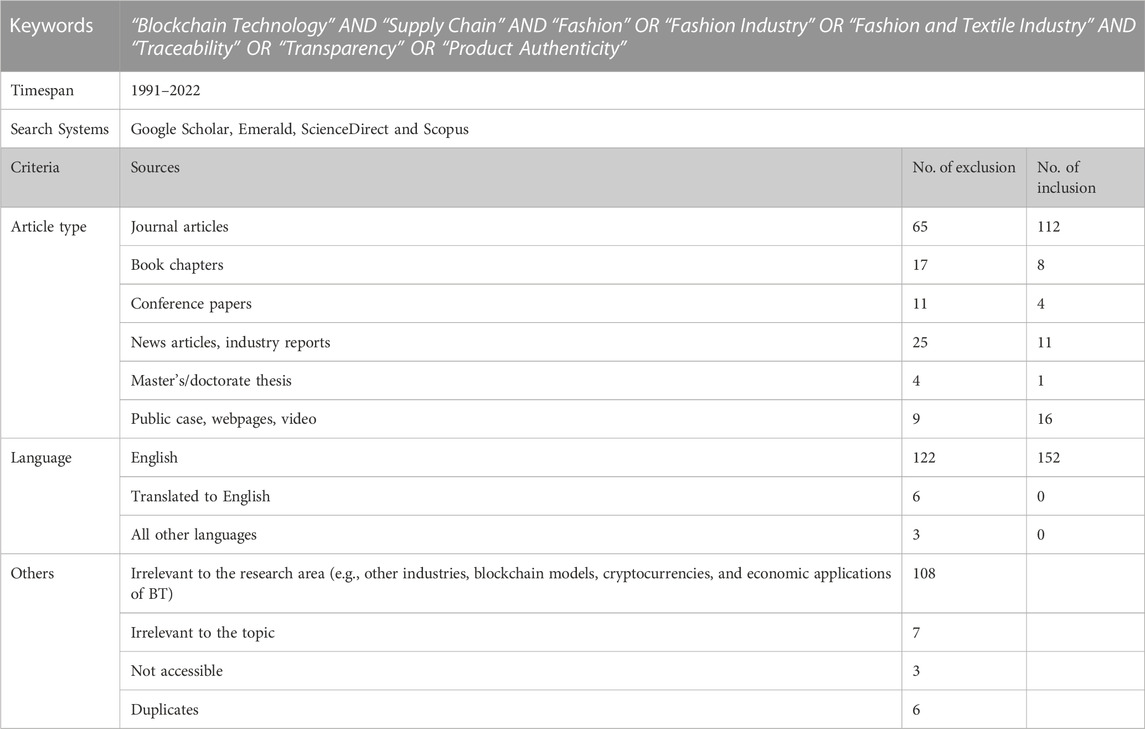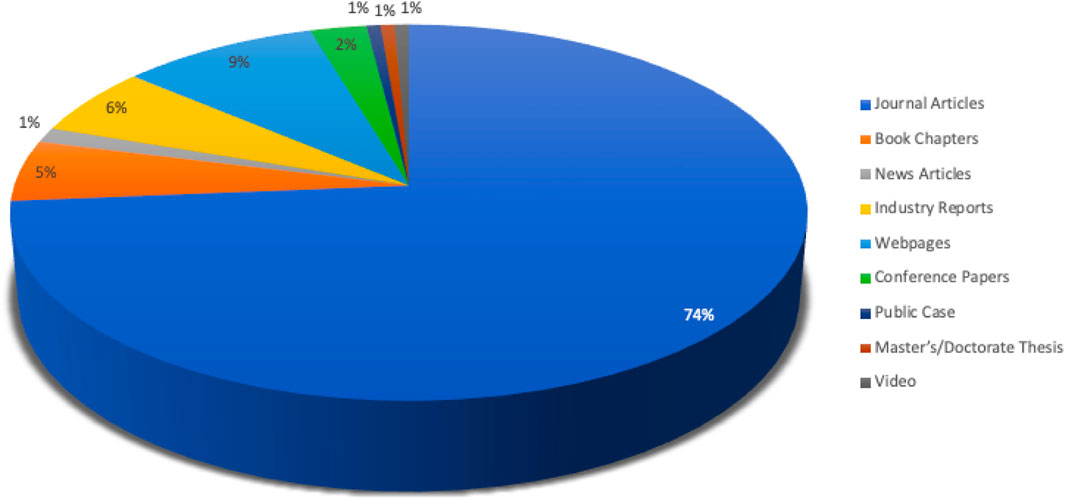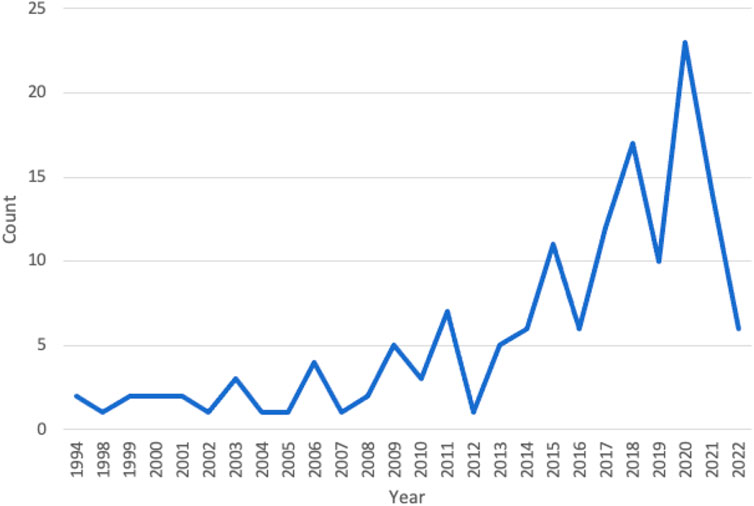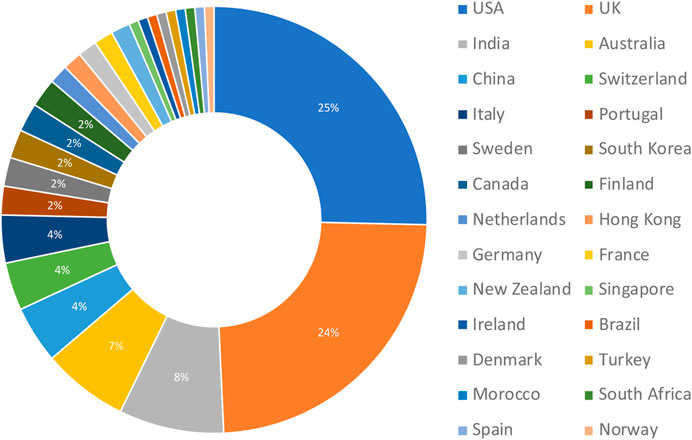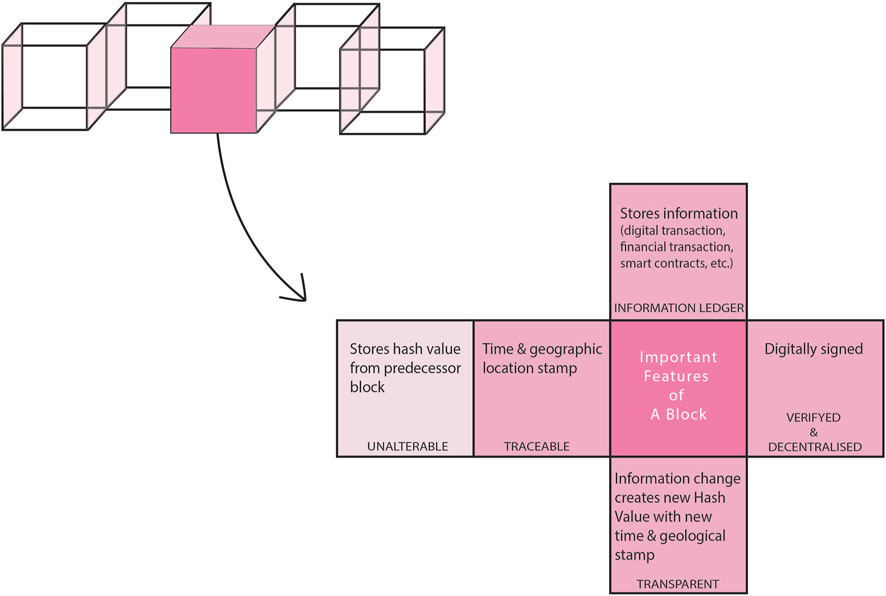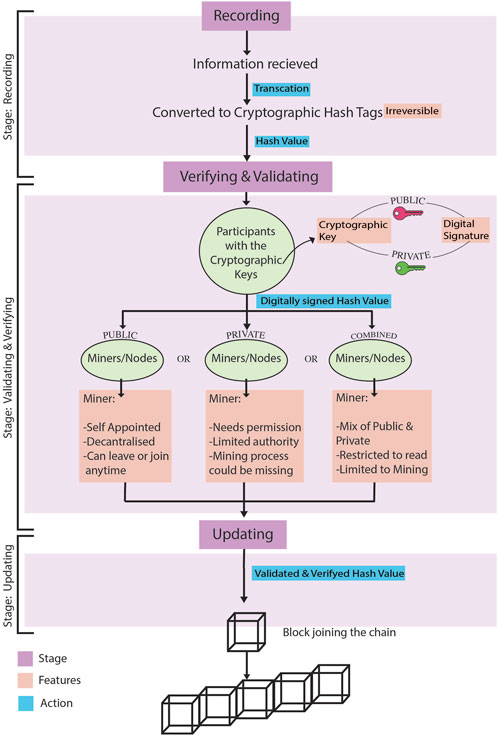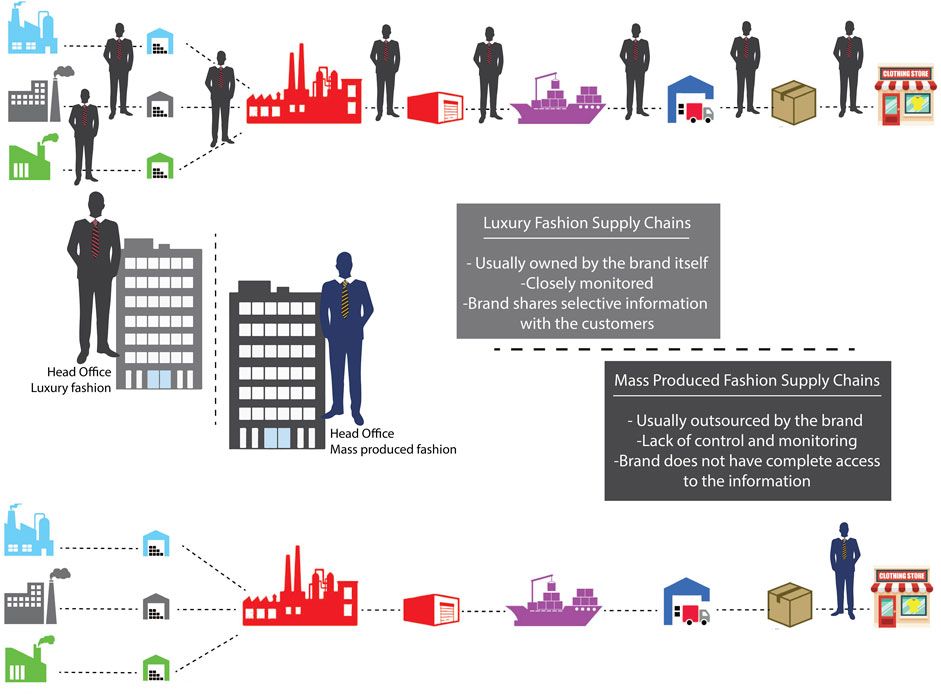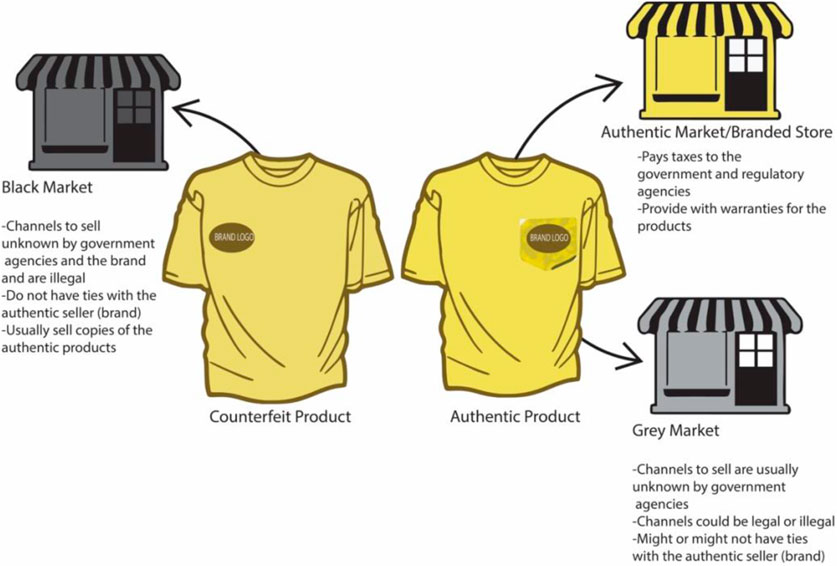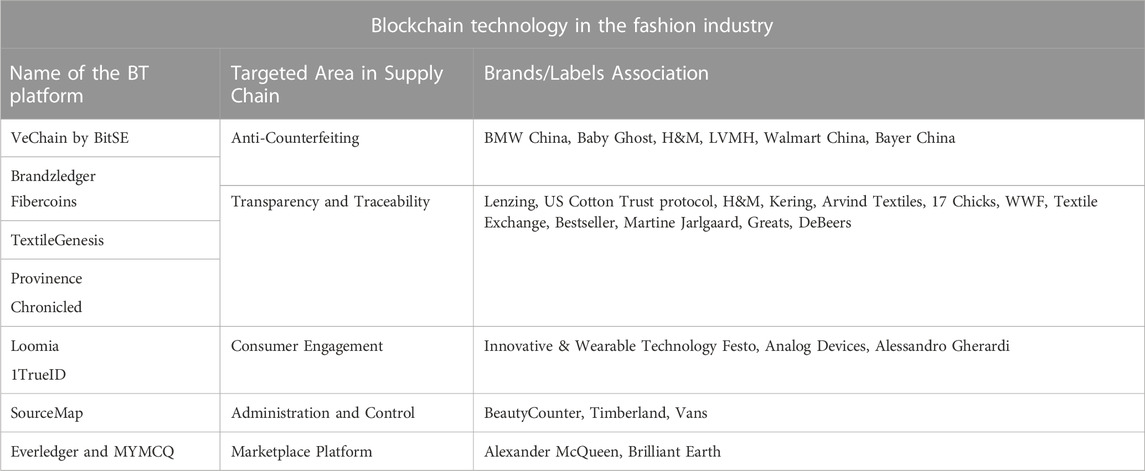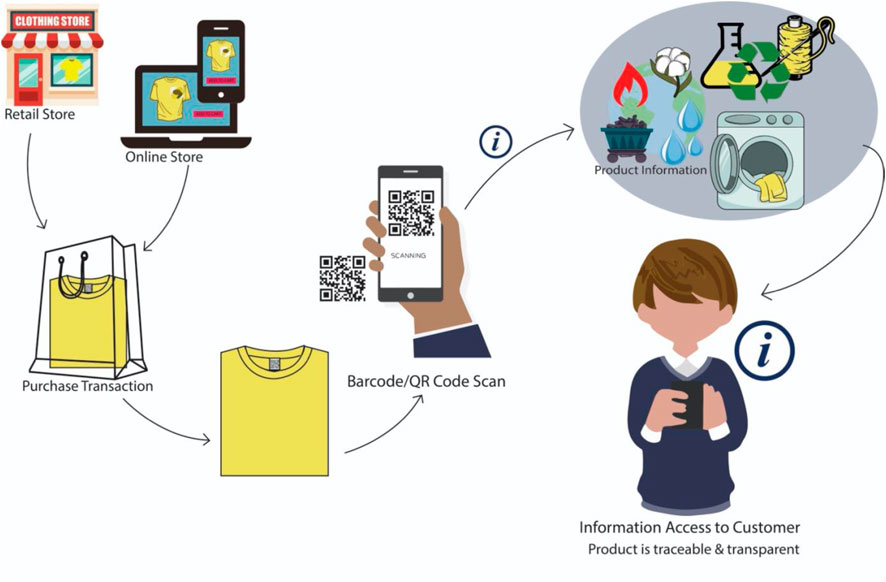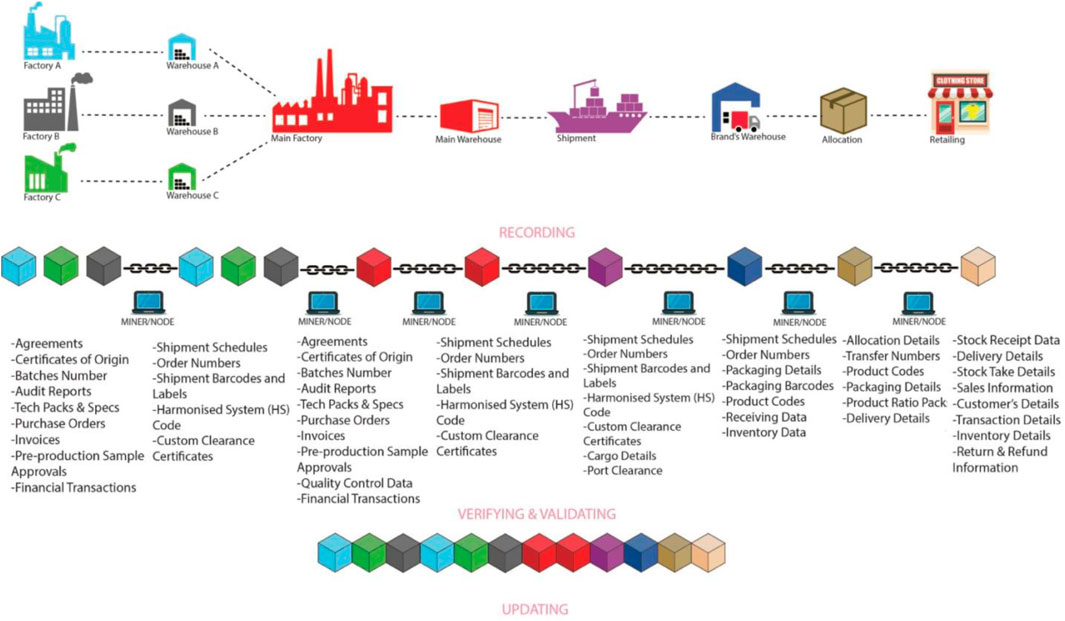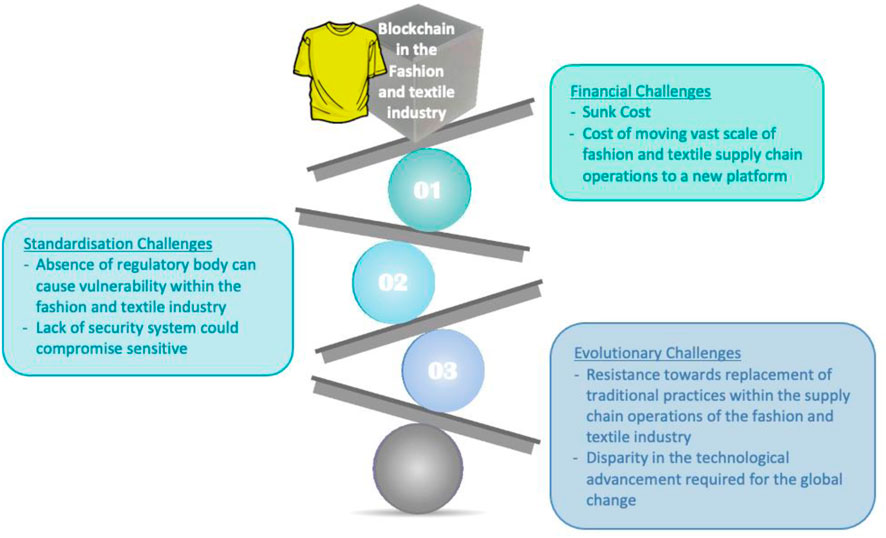- School of Fashion and Textiles, RMIT University, Melbourne, VIC, Australia
Blockchain Technology has shown tremendous potential to be a foundation for the currently shifting paradigm towards more traceable and transparent supply chains. This review highlights the opportunities that exist in adapting Blockchain Technology in the fashion and textile supply chain, while also providing insight into the challenges of adopting this technology. This paper provides a systematic review of the potential of Blockchain Technology within the fashion and textile industry’s supply chain to analyse its role in traceability, transparency, and product authenticity. To achieve this, a substantive number of research papers and non-scholarly resources have been scrutinised. An emphasis was placed on topics regarding Blockchain Technology (BT), the fashion and textile industry and supply chain (manufacturing and distribution), traceability, transparency, and product authenticity. The selected research papers range from empirical analysis, argumentative, case studies, opinion articles, review articles, short reports, and book chapters.
1 Introduction
The exciting emergence of Blockchain Technology (BT) has revolutionised many industries over the past decade (Kimani et al., 2020). BT is a decentralised and distributed digital ledger that allows for unalterable record-keeping (Ahad et al., 2020). The immutable feature of this technology has tremendous potential for the fashion and textile industry to improve its transparency and traceability in supply chain operations (Agrawal et al., 2018). Understanding the application of BT in the fashion and textile industry is a complex task due to the scale of the industry, which was valued at 1.5 trillion US dollars in 2021 and is estimated to reach 2 trillion by 2026 (Smith, 2022), as shown in Figure 1.
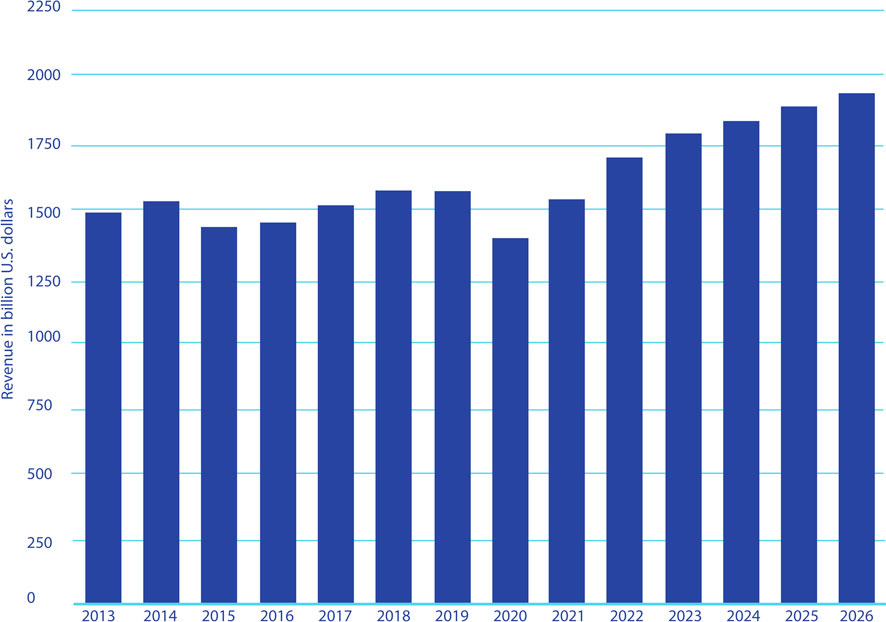
FIGURE 1. The global fashion and apparel industry value in billion U.S. Dollars from 2013 to 2026 (Smith, 2022).
Moreover, the fashion and textile industry is cluttered with complex supply chains (Garcia-Torres et al., 2019). The industry is dependent on global supply chains for manufacturing and distribution processes ranging from sourcing raw materials to catering finished products to customers (Masson et al., 2007). The inherent complexity of supply chains is often used to obscure the origin, tracing, and authenticity of fashion and textile products (Li, 2013). In addition, unethical and corrupt practices within supply chains, such as forced child labour, modern slavery, and disregard for the environmental consequences can be hidden from both the retailer and the customer (De Aguiar Hugo et al., 2021). While these cost-cutting practices can increase the retailer’s profit margin, they also have the potential to jeopardise the customer’s trust in their favourite brands and in extreme cases, also the customer’s health (Bikoff et al., 2015). The emergence of the COVID-19 pandemic has reiterated how essential it is to maintain healthy living and a natural balance with the planet. The retail landscape is set to resume normality, compared to before the pandemic, by the fourth quarter of 2023 (BoF-McKinsey&Company, 2021). While the world faced multiple lockdowns, unpredictable fluctuations in consumer trends created new opportunities for emerging technology in businesses. BT is one among the others which aided many businesses with maintaining their global supply chains while simultaneously enhancing the customer experience. This paper systematically reviews the potential of BT based on its inherent properties and capabilities in the manufacturing and distribution areas of the fashion and textile supply chain. The complex structure of the fashion and textile industry will be discussed emphasising the diverse and complex nature of their supply chains. This paper utilises a narrative approach of synthesising the information to bring the findings of the systematic review of the key research topics in structured summaries. This is achieved by mapping the narrative paragraphs under the thematic headings. This strategy has assisted in providing a structural flow to the relative evidence found within the course of conducting this review.
The diverse nature of the industry’s supply chains permits numerous loopholes to be exploited. The lack of traceability and transparency creates a disconnect between what is publicised and the harsh reality. Currently, there is a dearth of research in this field that provides a universally feasible framework to solve the existing concerns. BT exhibits promising potential to revolutionise the fashion and textile industry’s supply chain. In the fashion and textile industry, BT is yet to be applied to the entire supply chain, with current uses limited to solving niche problems rather than providing a holistic solution for the challenges of traceability and transparency. The limited exploration of BT features through experimental research has left countless challenges to be resolved. This paper highlights the existing research gaps while summarising the direction of current research in the field of BT in the fashion and textile industry. This paper also sheds light on the lack of transparency and traceability within these supply chains and how it impacts the industry’s ability to battle the counterfeit markets. Existing BT applications will be illustrated in sequence while highlighting the existing gaps in relevance to the fashion and textile industry’s supply chains. The paper concludes with the limitations and future recommendations based on the review of the existing research.
1.1 Background
The presented systematic review is the first attempt at bridging the problem which emerges from the lack of transparency and traceability within the fashion supply chains with the existing and potential solution, which is provided by BT. Additionally, this paper presents the review in a narrative summarisation of the challenges existing in the fashion and textile industry from the grass root level, such as highlighting the lack of universally adopted definitions of the key research topics like transparency and traceability with the industry’s context. It aims at illustrating the limitations and scope of future research which can boost the adoption of BT to solve the existing challenges within the fashion and textile supply chain.
It should be noted that research within the context of the application of BT in the fashion and textile industry does exist (Choi, 2019; Tripathi et al., 2021), however, has not been widely adopted by the industry (Caldarelli et al., 2021). BT and the relevant phenomenon within the fashion and textile industry are well-established and researched. The key research topics, such as, Blockchain Technology (BT), Supply Chain, Fashion, Fashion Industry, Fashion and Textile Industry, Traceability, and Transparency have further background information (history and definitions) incorporated in the narrative sections with the thematic headings, which are crucial for the findings of this review. The current systematic review addresses the lack of empirical evidence which results in the scarcity of life-cycle-assessment case studies (Ahmed and Maccarthy, 2021) related to the framework of the adoption of BT within the fashion and textile industry.
2 Methodology
This systematic review paper follows the five-step method proposed by Khan et al. (2003) to research the topic to ensure the reliability and transparency of this review. The five-step criteria are as follows.
a) Outline the question for review,
b) Classify related work,
c) Evaluate the quality of studies,
d) Summarise the findings, and
e) Interpret the results.
The proposed research question is, “What are the applications of blockchain within the fashion and textile manufacturing and distribution channels and, how does it impact the product’s traceability, transparency, and authenticity?.” A range of sources was identified to outline the relevant research work to explore the research question, as shown in Table 1. These sources were accessed using the databases such as, Google Scholar, ScienceDirect, Emerald, and Scopus. These sources were selected from different databases to avoid bias in selection. The shortlisted sources contain only published material to maintain the quality of this review. These sources were limited primarily to scholarly research which is presented originally or translated into English while also utilising non-scholarly research for supplementary evidence. Classification narrowed down the scholarly research work to peer-reviewed and cited research papers. This review utilised only trusted and credible global sources for non-scholarly research work such as Common Objective, Business of Fashion & McKinsey Company Industrial Reports, and The Washington Post. The sources examined for this review were selected using a transparent selection process by employing Preferred Reporting Items for Systematic Reviews and Meta-Analyses (PRISMA) to improve the quality of this review (Moher et al., 2009). The terms and keywords investigated in this review are: Blockchain Technology (BT), Supply Chain, Fashion, Fashion Industry, Fashion and Textile Industry, Traceability, Transparency, and Product Authenticity. Boolean Syntax was also applied to these terms to form desired combinations of the same with AND, and OR to find the most relevant work. The keywords were searched within the titles of the research resources. In total, 283 research resources were identified and further narrowed down to 152 based on their relevance and credibility by analysing the abstract. These papers were then shortlisted to 152 research resources which were analysed thoroughly to produce this review. The research was gathered for this review in 2021 and 2022, where it was found that BT was invented in 1991. Additionally, it was discovered that “Traceability”, one of the essential keywords, as defined by International Organisation for Standardisation (ISO) in 1994. Considering the above mentioned reasons, a range between 1991 and 2022 would provide a thorough search period for this review. However, the abundance of relevant resources which are reviewed to conduct this study to focus on the current state of the research topic is from 2011 to 2022. The exclusion and inclusion criteria for this review are based on relevancy, source type, language, and other factors which are summarised in Table 1, while the distribution of source types can be found in Figure 2.
Figure 3 illustrates the refinement process undertaken to build the research library for this review. The initial search resulted in 283 sources of which 6 duplicates were removed. 277 sources were further screened for their relevance to the review while also being filtered into those written or translated to English. 82 sources were excluded after this screening process and 195 sources were examined in detail. 43 sources were excluded after they were thoroughly read and found to be irrelevant.
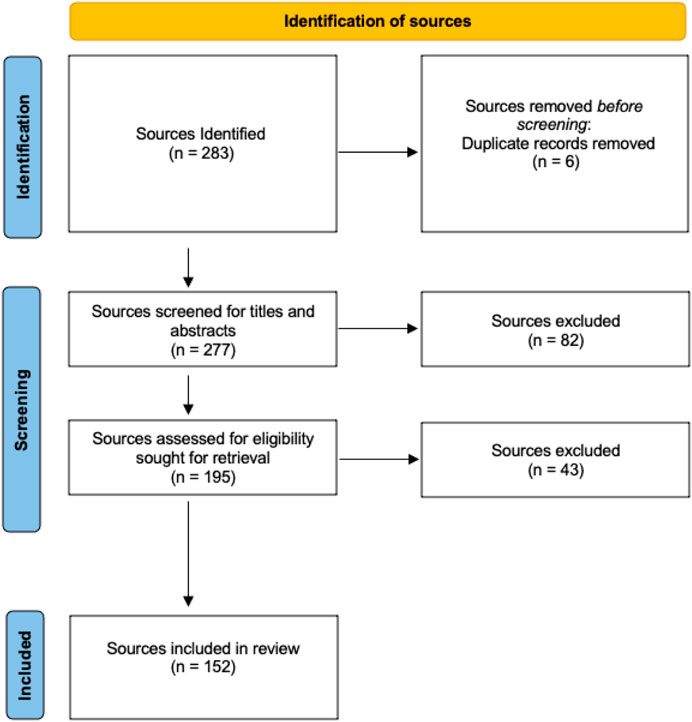
FIGURE 3. Refinement process based on PRISMA guideline (Adapted from Moher et al., 2009).
Figure 4 presents the yearly distribution from the 1990s to the 2020s of the sources included in the systematic review. BT was invented in 1991, however only gained a platform from 2008 onwards. Figure 4 contains 1994 as a starting point of the annual distribution as the ISO defined traceability in 1994. The abundance of the relevant and updated sources reviewed for this paper is from 2011 to 2022. Within the context of this systematic review, 23 articles were published in 2020. It is critical to note that the majority of the research articles used in this review were published during the last 5 years (2018–2022), which accounts for over 50% of the articles. The growth in the number of research articles reveals the heightened interest of the researchers in this specific area of study.
Figure 5 represents the most significant nations that contribute to the research which are included in this systematic review. A greater number (25% and 24%) of the research articles originated from United Kingdom and United States, followed by India and Australia.
3 Understanding Blockchain: Technology of the decade
Blockchain is a technology that has provided numerous businesses with a competitive technological edge in the last decade (Tripathi, et al., 2021). BT was invented by Stuart Haber and Scott Stornetta in 1991 (Kushwaha and Joshi, 2021) however, its global debut only occurred in 2008 when it was successfully applied to create “Bitcoin: A Peer-To-Peer Electronic Cash System” by Satoshi Nakamoto (Nakamoto and Bitcoin, 2008). This technology has become globally known as cryptocurrency however, BT’s application to the fashion and textile industry remains in the nascent stages of exploration.
BT uses a distributed ledger, meaning it is a consensus of shared and synchronised digital data which can be spread across multiple sites, institutions, and countries (Panda et al., 2021). There is no central administrator or centralised data storage which provides this technology with its main features like decentralisation and immutable history. BT uses cryptographic hashtags to store digital information in a block with a digital signature making it traceable. BT includes key features including, consensus and smart contracts which make this technology user-friendly to different types of industries (Kushwaha and Joshi, 2021). Upon validation of the block by consensus of the network, the block forms an unalterable chain. This unalterable state is achieved when to change a block in the chain (which can only be done by making a new block containing the same predecessor) one must regenerate all successor blocks and redo the work on regenerating the blocks. These blocks also contain time stamps and geo-location tags which makes this technology traceable in real-time (Drescher, 2017). Figure 6 illustrates some of these above-mentioned features which make BT immutable and traceable (Abeyratne and Monfared, 2016).
To recognise the properties of this technology, it is important to comprehend the fundamentals of its structure and functioning. A blockchain is a digital ledger of individual blocks. These blocks contain information and form a chain or jigsaw-like structure by attaching themselves to the other blocks in the chain. The information stored in the blocks can be of multiple origins and natures, such as a record of valid network activity, documents, and transactions (Abeyratne and Monfared, 2016). This information is stored in an encrypted form that is immutable and has a traceable history, which can be shared with the participants or stakeholders in the chain. The generation and addition of blocks to the chain take the form of a digital transaction (Bauerle, 2018). For example, a party (or participant) requests information or initiates a digital transaction that is recorded in a block. This block circulates in the chain and other participants can react and process this information with an appropriate response. This new information is then stored in this block. Common examples of this information are smart contracts and financial transactions (Crosby et al., 2016). Once this block is verified by all the participants, it is then added to the block permanently and the transaction is considered completed. It is pivotal to comprehend the procedure of creating blocks and their functional know-how in terms of security and storage capacity to understand its potential use cases (Drescher, 2017).
4 Creation of a block in a blockchain
The process of creating a block can be categorised into three important stages, as illustrated in Figure 7: recording; verifying and validating; and updating. Each stage has a different purpose in the formation of a block.
4.1 Recording
Information is received to initiate the transaction and converted into cryptographic hashtags (a fixed-size alphanumeric string) which are called hash values through a specific algorithm (Lemieux, 2016). These values are irreversible, meaning the output cannot be converted to the input. With every new input, a new hash value is generated to maintain its authenticity (Drescher, 2017).
4.2 Verifying and validating
This block is then circulated and distributed in the ledger network of miners, also known as nodes. Each miner has a public key and a private key which together form a digital signature. Any interaction or action, which includes time and geographical stamping, requires these keys (Crosby et al., 2016). These miners are members with the authority to validate the information stored in the block. Once these miners approach a majority with the same conclusion, the block is approved/validated to enter the next stage (Heiskanen, 2017).
4.3 Updating
This is the final stage when the block becomes part of the blockchain. This block will include the hash values of the proceeding blocks (Drescher, 2017). Therefore, to change a block in the chain, one must regenerate and redo all the successor blocks. This makes each previous block unalterable, as the output cannot be converted to the input.
BT has become well-known because of its applications and developments in cryptocurrencies such as Bitcoin and Ethereum. In addition to cryptocurrency, industries such as banking, health, and taxation, have been actively implementing BT to reap the advantages of numerous features provided by this technology (Kimani et al., 2020). Naturally, business operations and supply chain management departments, such as the fashion and textile industry (Tripathi et al., 2021), have piqued interest in potential applications of BT to address the complex nature of the supply chain. It has already been incorporated by several renowned luxury brands in segments of their supply chains and user interfaces to provide improved services to their customers (Choi, 2019). However, it is yet to be widely adopted by the fashion and textile industry (Caldarelli et al., 2021). To further evaluate this, the nature of the fashion industry and the relationship between transparency and traceability in fashion’s supply chain requires investigation.
5 Encompassing the fashion industry: Definition to the conventional reality
Through countless perspectives and debatable concepts, fashion can be defined as the exhibition of ideas and conscious concepts, articulated in clothes and ensembles (Entwistle, 2000). Major and Steele (Major and Steele, 2019) defined the fashion industry as, “part of a larger social and cultural phenomenon known as the “fashion system,” a concept that embraces not only the business of fashion but also the art and craft of fashion, and not only production but also consumption” (Islam, 2021). The multi-dimensional and layered structure of this industry makes it difficult to define it in a singular definition (Montagna, 2015). While philosophically fashion can be described as a form of art or self-expression, it is commonly conceptualised in a ‘costume-based’ meaning (Tamara et al., 2014).
The multi-billion-dollar fashion industry is constantly evolving while concurrently transitioning rapidly to digitisation and globalisation, even during the COVID-19 pandemic (Brydges et al., 2021). Witnessing massive consumer shifts and disrupted supply chains, the industry has been facilitating rigorous adaptation in sales via online media channels. Although, the fashion industry is in the recovery phase after losing growth during the pandemic period and researchers have predicted to reset the growth to normal 2019 by end of 2023 (BoF-McKinsey&Company, 2021).
Today’s fashion and textile industries are among the rapidly growing and advancing global industries with inherently complex and diverse supply chains (BoF-McKinsey&Company, 2020; BoF-McKinsey&Company, 2022). The ever-increasing complexity of the designs and competitive pricing; forces companies on a global hunt for new raw materials for manufacturing techniques and technology. The resulting supply chains are difficult to trace due to their vastness and distributed operations (Marshall et al., 2016). The complex and asymmetrical nature of the supply chains in the fashion and retail industry leaves loopholes which can be easily exploited.
The fashion and textile industry is constantly associated with: sweat shops; human rights breaches; pollution of the environment; black markets; unsustainable practices toward the planet and people (Kurpierz and Smith, 2020). The fashion and textile industry is infamously known to focus solely on maximising profit margins and low production costs. However, that cost is commonly compensated by child labour, modern-day slavery, fake audits, corruption, and fraudulent certifications (De Aguiar Hugo et al., 2021).
The fashion and textile industry are rapidly growing sectors that are highly subjective to the conceptions of business owners and consumers. Consequently, accountability resulting in negative publicity is limited and gets blurred especially in hazardous circumstances. The fashion industry is separated majorly into luxury fashion and mass-produced fashion. This results in a large variance in the operations of supply chains belonging to specific sectors. An understanding of the difference in the nature and functioning of different supply chains is essential to develop a global solution.
5.1 Fashion manufacturing and distribution: Fashion Industry’s complex supply chain
A supply chain is a series of activities to control and channel the flow of materials, parts, and products to the customer (Stevens and Johnson, 2016). Supply Chain Management (SCM) is a confusing term as it can be defined as a flow of: materials and products; or management philosophy; or branch of management; or management process (Tyndall, 1998). Depending on the nature of supply chains, there are many stakeholders involved, including but not limited to: producers, product assemblers, manufacturers, wholesalers, retailer merchants, and transporters (La Londe and Masters, 1994). Manufacturing companies adopt a supply chain management philosophy to establish management practices that allow them to operate continuously (Mentzer et al., 2001).
To understand the basic nature of the supply chains for the fashion industry, the luxury fashion industry should be separated and differentiated from the mass-produced apparel retail industry (Yang et al., 2017) as illustrated in Figure 8. The distinctions and differences between these two categories are highlighted below.
5.1.1 Mainstream and high-end luxury fashion industry
The high-end luxury ensembles and accessories are exclusively designed and manufactured for special orders, for example, couture houses that create fashion as a form of art (Raustiala and Sprigman, 2006). Luxury products are created specifically to cater to an exclusive segment of consumers who desire high-end products and can afford to pay for such. The cost of these high-end products is significantly higher than the mainstream fashion products. The high cost and exclusivity are justified by the creators and the brands as they incorporate the best quality raw material and precision manufacturing (Choi, 2020). In most cases, luxury brands control the design and quality of their products by owning the entire supply chain or opting for the most reliable manufacturer (Karaosman et al., 2017). Luxury brands own small and medium-sized manufacturing units to have complete control over their merchandise to protect the designs and gain competitive advantages (Jestratijevic and Rudd, 2018). Therefore, luxury brands commonly only share selective and generic information regarding their supply chains and instead communicate the product value through various marketing campaigns (Jestratijevic et al., 2020a). The discreet nature of supply chain operations and limited information provided by luxury brands, can raise suspicion about the transparency of the brand’s operations.
5.1.2 Mass-produced apparel and the retail industry
The mass-produced apparel and retail industry constitutes most of the affordable-fashion brands and labels which operate on a completely different supply chain model compared to luxury brands (Niinimäki et al., 2020). Fashion brands that target mass-produced apparel are seeking to manufacture products at the lowest cost to improve their profit margin. Making cheap and fast fashion has evolved into a business strategy for the apparel industry (Bhardwaj and Fairhurst, 2010; Moore, 2019; Nguyen, 2020). Fast-fashion brands are seeking manufacturers who can provide the lowest manufacturing time to keep up with changing trends. These strategies require low-cost human labour, high availability of manufacturing machinery, and high ease in sourcing raw materials for continuous production (Igwe and Kanyembo, 2019; Chen et al., 2020). Historically, capitalist businesses and brands have exploited developing nations because of the vast socio-economic gaps in their population segments. Resultantly, the lower socio-economic segment of the population is usually exploited to provide low-cost human labour in unethical supply chains (Strauss, 2012; Ikumapayi et al., 2020).
Fast-fashion brands rapidly manufacture large volumes of fashion products, catering to the mass population with the latest trends (Tsay et al., 1999; Bhardwaj and Fairhurst, 2010) and generally outsource their supply chain (Arora and Mittal, 2011). Brands with the ‘take-make-waste’ business model, commonly do not have ownership of their supply chains, resulting in limited control and increased complexity, compared to the luxury brands in the fashion and textile industry (Arrigo, 2021). There is immense pressure for the timely delivery of large-volume orders within the fast-fashion industry. Therefore, it is not surprising that the official manufacturers unofficially employ the third parties to outsources the manufacturing services, making the supply chain more complex and harder to trace (Farahani et al., 2014). Additionally, the audits are also executed in a fraudulent manner which restrains the issues in the supply chain from surfacing. The major impacts of these poorly and unethically managed supply chains are reflected in the health, safety, and rights of workers along with the environment (Cho et al., 2015; Ciasullo et al., 2017; Diouf and Boiral, 2017). These circumstances together create an opaque cloud over the traceability of the fashion and textile supply chains.
5.2 State of the fashion and textile industry: An ethical perspective
The fashion and textile industry infamously suffers heavily from poor working conditions. In 2012, Tazreen Fashion Factory in Dhaka, Bangladesh was engulfed in fire claiming 117 workers’ lives and leaving many injured. This devastating and catastrophic event was the first glimpse for many consumers, into the dark side of the fashion and textile supply chains (Saxena, 2020). This unfortunate incident was the cornerstone of mass campaigns in fashion history of consumer awareness (Omotoso, 2018) like, Who made my clothes? However, over the past decade, there has been a continuous string of fatal occurrences throughout the supply chain (CleanClothesCampaign, 2022). The Common Objective reported that at least 1600 workers have been confirmed killed in fatal accidents within the garment industry between 2012 and 2017 (CommonObjective, 2018b). In February 2020, another denim factory in India burnt to ashes, claiming the lives of 7 workers because of the poor fire exit procedures and routes demonstrating the broken and unfacilitated supply chain system that still operates with extremely hazardous conditions (Bellware, 2020). The Pulse of Fashion Industry Report 2017 estimated 1.4 million recorded injuries in the industry each year. This estimate is projected to have a hike of 7% to 1.6 million by 2030 (GFA, 2017). Figure 9 illustrates a timeline of fatal incidents which have been reported since 2012.
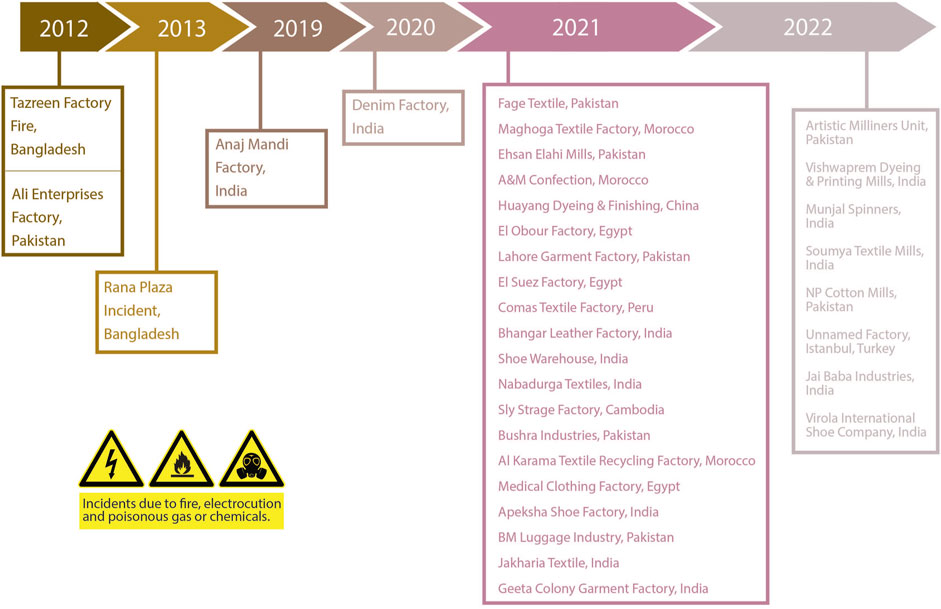
FIGURE 9. Timeline of hazardous and fatal accident in Fashion Industry since 2012, emphasising major accidents recently during 2021-2022.
According to the United Nations International Children’s Emergency Fund (UNICEF), more than 100 million children are affected by association with the fashion industry, specifically garment and footwear. Along with child labour, these children are also affected by: a lack of maternity protection; the absence of childcare facilities; and poor living and working conditions for garment worker communities (UNICEF, 2020). The United States Department of Labour reported that 51 countries around the globe use children in at least one part of the fashion and garment supply chain (CommonObjective, 2018a). In India, over half a million children work on cotton seeds in agriculture (ICN, 2015). While forced child labour in Uzbekistan is used for cotton cultivation and Syrian child refugees are used as labourers for Turkey’s garment industry. These are just some examples that have surfaced because of the challenges of fraudulent IDs and the lack of birth (UzbekForum, 2021). These examples are a small snapshot of the problems that arise without a transparent and traceable supply chain.
The fashion industry is currently facing the impacts of the pandemic in the form of logistics bottlenecks, increasing shipping costs, material shortages, and manufacturing delays (BoF-McKinsey&Company, 2022). As a result, the performance pressure on the supply chains is higher than ever. The fashion and textile industry is already the second most polluting industry because of the manufacturing processes. These processes involve the use of an excessive amount of chemicals that generate hazardous residues (Nimkar, 2018) and by-products (McFall-Johnsen, 2020). The fashion and textile industry is notorious for sharing selective information regarding its supply chain. Selective sharing is used as a technique to hide corrupt practices and remain unaccountable or to gain competitive advantages over others (Cho et al., 2015). These practices are only expected to increase in severity due to the increased pressure from the pandemic, while there is still no overarching system to keep the industry accountable for sustainability. Traceability and transparency could be essential tools to have sustainable supply chain management (Garcia-Torres et al., 2019).
Considering the above research, a conclusion can be drawn that a fully functional operating industry has many loopholes. These grey areas exist in both sub-sectors of the industry mentioned above: luxury and mass-produced. Both sub-sectors of the fashion industry share a mutual lack of traceability and transparency. Selective information disclosure and opaqueness in supply chain operations make the industry hard to penetrate and analyse the validity of sustainable practices. To discuss the topics of traceability and transparency, it is important to understand their origin and impacts on the world.
5.3 Traceability and transparency challenges within the fashion and textile industry
United Nations Sustainable Development Goal (SDG) #12 (UnitedNations, 2015) specifies the relevant information and awareness for sustainable development and lifestyles in harmony with nature, as outlined in Figure 10. Attaining traceability should be the first action plan for any industry, including fashion and textiles.
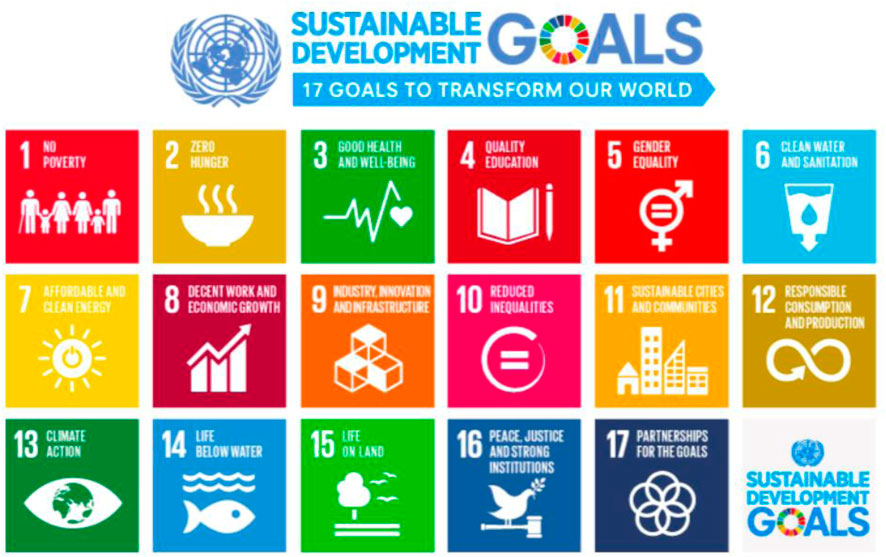
FIGURE 10. United Nation’s 17 sustainable development Goals (UnitedNations, 2015).
Honest communication across the supply chain and with consumers will be the next step as transparency (Papú Carrone, 2020). Understanding the true meaning of these two terms is as important as creating an action plan based on them.
5.3.1 Traceability
A general definition given by ISO in 1994 was the ability to trace the history, application, or location of an entity employing recorded identifications (ISO, I., 1994). ISO has defined traceability with modifications and improvements based on different industries. In the context of the food industry, in 2005 ISO defined it as the origin of materials and parts, the processing history, and the distribution and location of the product after delivery. However, it has not been defined in the context of the fashion and retail industry. Due to the inherent differences that are specific to the fashion and textile industry, the existing definitions and interpretations are not transferrable (Olsen and Borit, 2013).
5.3.2 Transparency
Transparency is defined as: relevant, timely, and reliable information, in written and verbal form (Williams, 2005). Ray and Das see it as the degree of openness when applied to corporate structures and is called corporate transparency (Ray and Das, 2009). Defining the terms through a business operational lens, is a tool to support organisation-stakeholder relationship (Wehmeier, 2018). However, all these attempts to define the term transparency blurs the grammatical boundaries as no official definition has been accepted in research (Phillips, 2011).
A growing cohort of customers is demanding transparency in the fashion and textile industry (James and Montgomery, 2017). Influential groups of customers are demanding action from their favourite brands to become transparent and accountable (Griplas, 2021). The use of terms like transparency and traceability to create a unique selling point is cultivating a lack of trust between customers and the fashion and textile industry (Dahl, 2010; Jestratijevic et al., 2020b). Fashion brands extensively rely on their brand image to keep the customers engaged. The use of media and celebrity endorsements is one of the oldest and most common strategies undertaken by brands to create and uphold the brand image (Erdogan, 1999). The fashion and textile industry lacks credible and non-selective information disclosure due to the extremely high stakes of losing and tempering the brand image (Jestratijevic et al., 2020a). This has also given rise to anti-consumption values among customers which is leading some major fashion brands to operate on similar trends (Lee et al., 2017). It can be challenging to ensure human rights and sustainable practices due to the complex structure of the supply chain, which sometimes involves multiple layers of undeclared stakeholders (Jestratijevic et al., 2018). This allows a huge gap for misinterpretation and uncertainty around brand perception which also restricts genuine communication between the brand and customers (Kang and Hustvedt, 2014). The driving force for the fashion and textile industry is consumer demand, however, some research indicates a lack of consumer interest in prioritising sustainable fashion (Carrigan and Attalla, 2001; Jørgensen et al., 2006). The lack of customer awareness of sustainable practices allows the industry to create confusion and greenwash their products. This leads to a lack of trust in green products and ethical production impacting the purchasing decision of sustainable fashion (Bhaduri and Ha-Brookshire, 2011; Saicheua et al., 2011; Pookulangara and Shephard, 2013). Transparent supply chain operations would remove this grey area that is often used by companies to greenwash their products and would likely promote customer interest in truly green products.
Along with manufacturers and producers, it is important to highlight the consumer’s role in shaping the fashion industry. For consumers, it filters down to self-awareness regarding consumption and willingness to make sufficient changes to create sustainable habits. SDG #17 as shown in Figure 10, contextualises the importance of partnership between governments, the private sector, and civil society (SDG, 2015). However, one of the biggest challenges in this regard is the flooding of the market with counterfeit copies of authentic products. It not only impacts brands directly but also is responsible for the consumer’s mindset. Therefore, it is important to understand the challenges of the counterfeiting and grey market in the fashion and textile industry and its impact on product authenticity.
5.4 Counterfeiting and the grey market: Product authenticity
Counterfeit goods are one of the fastest-growing industries in the world. It is also one of the oldest organised crimes in history (Hamelin et al., 2013). It thrives in a parasitic relationship with other industries which have valuable products with expensive prices or heavy consumption to make it profitable with moderate prices. Pharmaceuticals, antiques and art pieces, jewellery, and watches, toys, mobile phones and accessories are some of the industries other than the fashion and textile industry that is suffering from counterfeit goods (Chaudhry and Stumpf, 2011; Antonopoulos et al., 2020). In 2015, the World Economic Forum estimated that the piracy and counterfeit markets cost the global economy an estimated USD 1.77 trillion, which is nearly 10% of the global merchandise trade (Gregson and Crang, 2017). Counterfeit fraud is described as an enormous drain on the global economy by the International Chambers of Commerce (Hardy, 2011). It steals billions of dollars from the legitimate economy to fund undisclosed, underground industries. For counterfeit products, the money trail is untraceable which hinders the revenue collection by the government and increases the burden on taxpayers. It also allows poor-quality merchandise to enter the market and exposes consumers to these dangerous products (Hardy, 2011). However, it is difficult to estimate the actual size of the global grey market and counterfeit economy because of its non-traceable existence. The variance of laws and regulations in various parts of the world also adds to this problem (Antonopoulos et al., 2020).
Counterfeiting products is a multi-leveled activity that varies depending on the nature of the business operation ranging from deceptive or non-deceptive; low quality or high-quality fakes; condoned copies; or copies of genuine products (Dugato et al., 2015). The counterfeiting of fashion products comes under the scope of non-safety critical goods, however, beauty and fragrances come under the scope of safety-critical goods as they can significantly affect consumer’s health and safety (Large, 2015; Van Duyne et al., 2015). The counterfeiting economy can be underlined as organised crime and the crime money generated is usually a corruptive force for the global economy. The counterfeit market is a threat to social life and overall global stability (Reuter, 2013).
The counterfeit economy thrives on consumer demand for products that are popular and brands that are famous (Delener, 2000; Hamelin et al., 2013), as they serve the purpose of social-adjustive for the consumers (Wilcox et al., 2009; Pham et al., 2018). Consumers playing a vital role in upholding the counterfeit economy can transact for the products in two ways, deceptively or non-deceptively (Wilcox et al., 2009). A deceptive counterfeiting transaction takes place when a consumer buys a particular brand or product thinking it is from a known and authentic brand, however in reality is an original product. On the other hand, in a non-deceptive transaction, a consumer willingly takes part in the counterfeit transaction (Hopkins et al., 2003). Counterfeiting of fashion products can be easier as they are aspirational goods that are relatively easier to produce. Fashion products also have non-uniform restrictions and the act of copying designs, in the name of inspiration, is forgiven to some degree within the industry (Hilton et al., 2004). For a legitimate business, intellectual property infringements can vary from using a designer/creator’s name to using a brand’s emblem/logo, or patent designs (Wall and Large, 2010). Not only do brands and businesses have to constantly safeguard the integrity of their products but they also constantly struggle to uphold the brand image (Green and Smith, 2002).
The grey market refers to the unauthorised distributional channels where branded products are sold in comparison to counterfeiting products which can be defined as selling products which are copied or not genuine (Li et al., 2016). Unlike the black market where counterfeit or stolen products are sold, the grey market is more complex to combat (Autrey et al., 2014). The grey market has thrived with developments in technology and e-commerce channels that allow new ease of doing business with new trade treaties and policies (Meraviglia, 2018; Wang et al., 2020b). In general, luxury brands are the biggest targets of the grey market and usually lose 5%–10% of their sales because of it (Shannon, 2018). The grey market and its impact are not yet fully established. However, it is argued to erode brand image and reduce the brand’s profit margins while injecting inferior substitutes of authorised products into the market (Ahmadi et al., 2015). Figure 11 illustrates the difference between an authentic market, a black market, and a grey market. The black market and grey market channels collaboratively challenge the credibility of the brands.
The different markets emphasise how product authenticity is crucial and significant (Bian and Moutinho, 2009). The authenticity of products is commonly only described when being compared to their inauthentic counterpart (Fionda and Moore, 2009). Resulting, the value behind authenticity is reserved for high-value products, especially in the luxury fashion industry (Keller et al., 2011). The value of authenticity depends on consumer perception (Napoli et al., 2014). For a brand, authenticity means incorporating features like the brand’s history and heritage (Brown et al., 2003), craftsmanship (Beverland, 2006), nostalgia (Beverland et al., 2008), sincerity (Thompson et al., 2006), quality (Beverland, 2006), and design consistency (Beverland et al., 2008). Product authenticity is associated with brand authenticity and brand value (Turunen, 2018) which makes it a holistic marketing tool to initiate and maintain brand loyalty and attachment among consumers (Choi et al., 2015). This provides the brands an edge to fight counterfeit products circulating in black and grey markets (Pham et al., 2018). Therefore, defending product authenticity is crucial and many brands are using technology as a means to communicate the value of the product to consumers (Franco et al., 2019; Wang et al., 2020b). Businesses that are targeting sustainable operations to maintain balance among the people, the planet, and profit are also exploring the application of technology to implement traceability and transparency throughout their networks (Kumar et al., 2017). However, it is also important to communicate and educate the consumers at the same time.
For the same reason, a completely traceable supply chain is required to have transparent communication between the consumer and industry (Ospital et al., 2022). Traceable supply chains allow both sustainable development to be validated and also safeguard the businesses’ own interests and profits. Current sustainability and transparency measurement tools, for example, the Higg Index, have not provided a solution to this problem (Gunther, 2016). There is a lack of technological solutions which address the concerns which arise from the lack of traceability in the fashion and textile industry. In summary, a holistic and feasible solution is urgently required for the fashion and textile industry to solve the plethora of supply chain issues. BT is a technological advancement that has gained interest in many industries including the fashion and textile industry. BT is envisaged as a potential solution to improve the overarching issues of traceability and transparency in the fashion and textile industry (Putasso et al., 2019; Treiblmaier and Tumasjan, 2022).
6 Applications of blockchain
Blockchain has become popular because of its features and advantages like the avoidance of data tampering and its capacity to facilitate large networks. Current applications are mostly fixated on using this technology to inform consumers about products and their features rather than utilising BT to provide a transparent supply chain that is not infected by asymmetric information disclosure and the complexity of globalisation (Agrawal et al., 2018).
As illustrated in Table 2, BitSE and Babyghost have collaborated (Martén, 2017), to develop VeChain and Brandzledger (Putasso et al., 2019) which are seamless applications of BT as an anti-counterfeiting solutions (Kshetri, 2017). Fibercoins is another application of BT that is based on a cryptocurrency model to eliminate legal and financial risks for users (Ahmed and Maccarthy, 2021). TextileGenesis and Fibercoins have collaborated to provide a unified application of BT which discloses a traceable journey of a product from the fibre stage to the end-customer (FiberCoin, 2022; TextileGenesis, 2022). Figure 12 illustrates the potential mapping of BT applications to enhance consumer experience and their access to the traceability and transparency of the products. In the context of traceability, this technology has been implemented by Chronicled and Provinence for Martine Jarlgaard (Putasso et al., 2019). BT applications can also enhance a customer’s trust in fashion and lifestyle brands. Leaders in this space include Socios, Loomia, 1 TrueID, and Alessandro Gherardi, NeuFund, AmaZix, and Timeless Luxury Group (Putasso et al., 2019; Panda et al., 2021). BT applications for supply chain management have been explored by Faizod and SourceMap (Panda et al., 2021). In the field of the marketplace, Alexander McQueen and Everledger have created a blockchain-enabled platform called MYMCQ. It becomes quickly apparent that an overarching and complete solution is yet to be implemented within the fashion and textile industry.
The fashion and textile industry is yet to explore the vast area of technical information which can help in the sustainable management of supply chains (Wang et al., 2020a). This technology offers the potential to solve some of the root problems in the industry. The fashion and textile industry has a distributed supply chain that is threatened by the infiltration of unauthorised parties in their manufacturing processes (ElMessiry and ElMessiry, 2018). Another advantage of this technology is to limit counterfeits in the market, which causes companies to lose profits and circulate potentially hazardous products in the market. Fashion as an industry is exposed to many other industries which contribute to its supply chain. Therefore, BT can act as an additional security blanket to protect the authenticity of the products (Tripathi et al., 2021). BT can facilitate quality control and check processes by making them time and cost-efficient (ElMessiry and ElMessiry, 2018). A potential application of blockchain in the fashion industry’s supply chain is illustrated in Figure 13.
The implementation strategy of this technology in the fashion and textile industry is still in its infancy in the context of supply chain. Industries such as civil construction and food-based agribusinesses have successfully moved their supply chains to a blockchain platform to make a traceable and transparent operational structure (Hultgren and Pajala, 2018; Sander et al., 2018). Several other industries are exploring the benefits of the application of this technology alongside cryptocurrency are food, health, education, events, entertainment, and cybersecurity (Tripathi et al., 2019; Ahad et al., 2020; Tripathi et al., 2020; Panda et al., 2021; Düdder et al., 2022; Thakur, 2022).
7 Key challenges in embracing blockchain technology
Despite a promising future, there is still a myriad of challenges for BT to be adopted within the fashion industry. This technology is in its nascent stage and requires further investigation to test its feasibility and overcome the various challenges as shown in Figure 14.
Technological immaturity is one of the key challenges yet to be overcome followed by its sunk cost (Agrawal et al., 2018; Kouhizadeh et al., 2020). The massive scale of operations involved in the fashion and textile supply chain could contribute significantly to this expense (Khanfar et al., 2021). Decentralisation is a feature of BT, representing an absence of a regulatory body, however, its application could leave the fashion and textile industry vulnerable (Trautman, 2014; Jabbar et al., 2020). Lack of standardisation and structure may result in unnecessary disclosure of sensitive information in the pursuit of increased compatibility of BT (Mistry et al., 2020). In the initial stages, integrating BT within business models may be difficult as it replaces traditional practices and operations (Cole et al., 2019). As more aspects of the business are incorporated into a blockchain channel, the security of that channel becomes crucial. A weak security system may lead to intellectual property concerns and the loss of valuable information (Anderson, 2018). Along with all the above-mentioned challenges, the complexity of the fashion and textile industry’s supply chain makes its integration into BT challenging. There are examples of BT in fashion’s supply chain in specific fields as mentioned in Section 6. However, due to the inherent vastness of the supply chain, an overarching and singular application for traceable and transparent transactions has not been achieved yet. Additionally, the existing applications of BT are not universally adopted by the industry.
8 Discussion, limitations, and future research directions
This literature review aims to bridge the knowledge gap between BT and the fashion and textile industry industries to promote the future application of BT to contribute to both industries. The current review has three main limitations and highlights gaps in the extant literature that could be addressed with further research. First, although this review has been conducted in a well-organised manner, it lacks grey literature as most of the sources reviewed for this research are either traditional commercial or academic publishing only in the English language. Second, this review found limited applications of BT within the fashion and textile industry, therefore, limiting the presentation of BT applications in the fashion and textile supply chain. Since BT has tremendous potential to recast the supply chain operations of the fashion and textile industry, this review instead highlights the novelty of BT in the fashion and textile industry. Further research is required through theoretical and practical lenses considering BT’s application to the fashion and textile industry’s complex and ungeneralised supply chains (Agrawal et al., 2018; Agrawal and Pal, 2019). Third, this review found an abundance of research resources, regarding the keywords mentioned in Section 2, Methodology, in journals from the field of law, technology, management, and innovation. However, a very limited number of resources within the journals of the fashion and textile industry were found. This review highlights that BT applications enabling a traceable supply chain specific to the fashion and textile industry lack empirical evidence and life-cycle-assessment case studies (Ahmed and Maccarthy, 2021). This review recommends further research to address this current gap in the literature mentioned above. The fashion and textile industry-specific research will also assist with the concerns around the legal protection of creative designs, contracts, and other transactions which are available on any BT platform. Therefore, the application of BT in the fashion and textile industry requires more structure as well as further research into its alignment with traditional law systems (Anderson, 2018). It is important to explore BT’s applicability and conduct studies based on real-life business examples adopting it as a platform for supply chain operations in the fashion and textile industry (Cole et al., 2019).
This review paper aims to understand the potential of BT in assisting the fashion and textile industry in fighting its daily challenges based on the existing research. The fashion and textile industry is one of the largest and fasting growing industries in the world, providing employment opportunities and one of the primary requirements for people: clothing. The varied nature of supply chains inherently leaves multiple loopholes within their functionality while also adopting concepts like sustainability, traceability, and transparency which are subjective. Current research shows a large consensus that the fashion and textile industry’s supply chain lacks traceability and transparency. There are established connections between important aspects of sustainability with traceability and transparency. However, there is a deficiency of research that suggests an executable plan to resolve the current concerns which are crafting long-lasting and undesirable effects on the planet. BT has recast many industries and contains the potential to refashion the fashion industry. However, the limited substantial use of BT in the supply chain of the fashion and textile industry and the limited exploration of its features through experimental research has left countless challenges to be resolved.
Author contributions
AB conducted the systematic literature review and was the major contributor to writing the manuscript. SI and CT continuously reviewed the manuscript throughout the process. All authors read and approved the final manuscript.
Conflict of interest
The authors declare that the research was conducted in the absence of any commercial or financial relationships that could be construed as a potential conflict of interest.
Publisher’s note
All claims expressed in this article are solely those of the authors and do not necessarily represent those of their affiliated organizations, or those of the publisher, the editors and the reviewers. Any product that may be evaluated in this article, or claim that may be made by its manufacturer, is not guaranteed or endorsed by the publisher.
Abbreviations
BoF, Business of Fashion; BT, Blockchain technology; GFA, Global Fashion Agenda; ICN, India Committee of the Netherlands; ISO, International Organisation for Standardisation; SCM, Supply Chain Management; SDG, Sustainable Development Goals; UNICEF, United Nations International Children’s Emergency Fund; USD, United Stated Dollar.
References
Abeyratne, S. A., and Monfared, R. P. (2016). Blockchain ready manufacturing supply chain using distributed ledger. Int. J. Res. Eng. Technol. 5, 1–10. doi:10.15623/ijret.2016.0509001
Agrawal, T. K., and Pal, R. (2019). Traceability in textile and clothing supply chains: Classifying implementation factors and information sets via Delphi study. Sustain. (Basel, Switz. 11, 1698. doi:10.3390/su11061698
Agrawal, T. K., Sharma, A., and Kumar, V. (2018). Blockchain-based secured traceability system for textile and clothing supply chain. Singapore: Springer Singapore.
Ahad, M. A., Paiva, S., Tripathi, G., and Feroz, N. (2020). Enabling technologies and sustainable smart cities. Sustain. cities Soc. 61, 102301. doi:10.1016/j.scs.2020.102301
Ahmadi, R., Iravani, F., and Mamani, H. (2015). Coping with gray markets: The impact of market conditions and product characteristics. Prod. Operations Manag. 24, 762–777. doi:10.1111/poms.12319
Ahmed, W. A. H., and Maccarthy, B. L. (2021). Blockchain-enabled supply chain traceability in the textile and apparel supply chain: A case study of the fiber producer, lenzing. Sustain. (Basel, Switz. 13, 10496. doi:10.3390/su131910496
Anderson, S. (2018). The missing link between blockchain and copyright: How companies are using new technology to misinform creators and violate federal law. N. C. J. Law Technol. 19, 1.
Antonopoulos, G. A., Hall, A., Large, J., and Shen, A. (2020). Counterfeit goods fraud: An account of its financial management. Eur. J. Crim. policy Res. 26, 357–378. doi:10.1007/s10610-019-09414-6
Arora, S., and Mittal, S. (2011). Intensifying export performance through planned capacity building: A study of the Indian apparel sector. J. Glob. Fash. Mark. 2, 20–27. doi:10.1080/20932685.2011.10593079
Arrigo, E. (2021). Collaborative consumption in the fashion industry: A systematic literature review and conceptual framework. J. Clean. Prod. 325, 129261. doi:10.1016/j.jclepro.2021.129261
Autrey, R. L., Bova, F., and Soberman, D. A. (2014). Organizational structure and gray markets. Mark. Sci. 33, 849–870. doi:10.1287/mksc.2014.0869
Bauerle, N. (2018). How does blockchain technology work. Retrieved from coindesk. Available at: https://www.coindesk.com/information/how-does-blockchain-technology-work (Accessed March 19, 2022).
Bellware, K. (2020). in Seven people died when the only escape from a fire at an Indian denim factory was up a ladder. Editor T. W POST.
Beverland, M. B., Lindgreen, A., and Vink, M. W. (2008). Projecting authenticity through advertising: Consumer judgments of advertisers' claims. J. Advert. 37, 5–15. doi:10.2753/joa0091-3367370101
Beverland, M. (2006). The ‘real thing’: Branding authenticity in the luxury wine trade. J. Bus. Res. 59, 251–258. doi:10.1016/j.jbusres.2005.04.007
Bhaduri, G., and Ha-Brookshire, J. E. (2011). Do transparent business practices pay? Exploration of transparency and consumer purchase intention. Cloth. Text. Res. J. 29, 135–149. doi:10.1177/0887302x11407910
Bhardwaj, V., and Fairhurst, A. (2010). Fast fashion: Response to changes in the fashion industry. Int. Rev. retail, distribution consumer Res. 20, 165–173. doi:10.1080/09593960903498300
Bian, X., and Moutinho, L. (2009). An investigation of determinants of counterfeit purchase consideration. J. Bus. Res. 62, 368–378. doi:10.1016/j.jbusres.2008.05.012
Bikoff, J. L., Heasley, D. K., Sherman, V., and Stipelman, J. (2015). Fake it’til we make it: Regulating dangerous counterfeit goods. J. Intellect. Prop. Law Pract. 10, 246–254. doi:10.1093/jiplp/jpv016
BOF-MCKINSEY&COMPANY (2020). The state of fashion 2020. The State of Fashion ed. London: McKinsey & Company.
BOF-MCKINSEY&COMPANY (2021). The state of fashion 2021. The State of Fashion ed. London: McKinsey & Company.
BOF-MCKINSEY&COMPANY (2022). The state of fashion 2022. The State of Fashion ed. London: McKinsey & Company.
Brown, S., Kozinets, R. V., and Sherry, J. F. (2003). Teaching old brands new tricks: Retro branding and the revival of brand meaning. J. Mark. 67, 19–33. doi:10.1509/jmkg.67.3.19.18657
Brydges, T., Heinze, L., Retamal, M., and Henninger, C. E. (2021). Platforms and the pandemic: A case study of fashion rental platforms during COVID-19. Geogr. J. 187, 57–63. doi:10.1111/geoj.12366
Caldarelli, G., Zardini, A., and Rossignoli, C. (2021). Blockchain adoption in the fashion sustainable supply chain: Pragmatically addressing barriers. J. Organ. Change Manag. 34, 507–524. doi:10.1108/jocm-09-2020-0299
Carrigan, M., and Attalla, A. (2001). The myth of the ethical consumer–do ethics matter in purchase behaviour? J. consumer Mark. 18, 560–578. doi:10.1108/07363760110410263
Chaudhry, P. E., and Stumpf, S. A. (2011). Consumer complicity with counterfeit products. J. Consumer Mark. 28, 139–151. doi:10.1108/07363761111115980
Chen, Y., Chung, S.-H., and Guo, S. (2020). Franchising contracts in fashion supply chain operations: Models, practices, and real case study. Ann. Operations Res. 291, 83–128. doi:10.1007/s10479-018-2998-5
Cho, C. H., Laine, M., Roberts, R. W., and Rodrigue, M. (2015). Organized hypocrisy, organizational façades, and sustainability reporting. Account. Organ. Soc. 40, 78–94. doi:10.1016/j.aos.2014.12.003
Choi, H., Ko, E., Kim, E. Y., and Mattila, P. (2015). The role of fashion brand authenticity in product management: A holistic marketing approach. J. Prod. Innovation Manag. 32, 233–242. doi:10.1111/jpim.12175
Choi, K.-H. (2020). A systematic review exploring the current state of fashion criticism-A focus on the fashion designer exhibition reviews of fashion theory. J. Korean Soc. Cloth. Text. 44, 273–294. doi:10.5850/jksct.2020.44.2.273
Choi, T.-M. (2019). Blockchain-technology-supported platforms for diamond authentication and certification in luxury supply chains. Transp. Res. Part E Logist. Transp. Rev. 128, 17–29. doi:10.1016/j.tre.2019.05.011
Ciasullo, M. V., Cardinali, S., and Cosimato, S. (2017). A strenuous path for sustainable supply chains in the footwear industry: A business strategy issue. J. Glob. Fash. Mark. 8, 143–162. doi:10.1080/20932685.2017.1279066
Cleanclothescampaign, (2022). Deaths and injuries in the global garment industry. Netherlands: Clean Clothes Campaign.
Cole, R., Stevenson, M., and Aitken, J. (2019). Blockchain technology: Implications for operations and supply chain management. Supply chain Manag. 24, 469–483. doi:10.1108/scm-09-2018-0309
COMMONOBJECTIVE (2018a). Child labour in the fashion industry. [Online]. Available: https://www.commonobjective.co/article/child-labour-in-the-fashion-industry (Accessed November 12, 2021).
Crosby, M., Pattanayak, P., Verma, S., and Kalyanaraman, V. (2016). Blockchain technology: Beyond bitcoin. Appl. Innov. 2, 71.
Dahl, R. (2010). Green washing: Do you know what you’re buying? Durham, United States: National Institute of Environmental Health Sciences.
De Aguiar Hugo, A., De, N. A. D. A. E., and Da Silva Lima, R. (2021). Can fashion Be circular? A literature review on circular economy barriers, drivers, and practices in the fashion industry's productive chain. Sustainability 13, 1224613–1231050. doi:10.3390/su132112246
Diouf, D., and Boiral, O. (2017). The quality of sustainability reports and impression management: A stakeholder perspective. Account. Auditing, Account. 30, 643–667. doi:10.1108/aaaj-04-2015-2044
Drescher, D. (2017). Blockchain basics: A non-technical introduction in 25 steps. Apress, Frankfurt-am-Mein. doi:10.1007/978-1-4842-2604-9
Düdder, B., Bager, S. L., Henglein, F., Herbert, J. M., and Wu, H. (2022). Event-based supply chain network modeling: Blockchain for good coffee. Front. Blockchain 5. doi:10.3389/fbloc.2022.846783
Dugato, M., Favarin, S., and Camerini, D. (2015). Estimating the counterfeit markets in Europe. Milan: Transcrime Research in Brief.
Elmessiry, M., and Elmessiry, A. (2018). Blockchain framework for textile supply chain management: Improving transparency, traceability, and quality. Cham: Springer International Publishing.
Entwistle, J. (2000). The fashioned body: Fashion, dress, and modern social theory. Malden, MA: Polity Press.
Erdogan, B. Z. (1999). Celebrity endorsement: A literature review. J. Mark. Manag. 15, 291–314. doi:10.1362/026725799784870379
Farahani, R. Z., Rezapour, S., Drezner, T., and Fallah, S. (2014). Competitive supply chain network design: An overview of classifications, models, solution techniques and applications. Omega 45, 92–118. doi:10.1016/j.omega.2013.08.006
FIBERCOIN (2022). Welcome to FiberCoin official website. [Online]. Available: https://fibercoin.tk (Accessed January 2, 2022).
Fionda, A. M., and Moore, C. M. (2009). The anatomy of the luxury fashion brand. J. brand Manag. 16, 347–363. doi:10.1057/bm.2008.45
Franco, J. C., Hussain, D., and Mccoll, R. (2019). Luxury fashion and sustainability: Looking good together. J. Bus. Strategy 41, 55–61. doi:10.1108/jbs-05-2019-0089
Garcia-Torres, S., Albareda, L., Rey-Garcia, M., and Seuring, S. (2019). Traceability for sustainability – literature review and conceptual framework. Supply chain Manag. 24, 85–106. doi:10.1108/scm-04-2018-0152
GFA (2017). “Pulse of the fashion industry 2017,” in Pulse Report of the Fashion industry. copenhagen: GFA, bcg, sac. Editor G. F. AGENDA (København, Denmark: Global Fashion Agenda).
Green, R. T., and Smith, T. (2002). Executive insights: Countering brand counterfeiters. J. Int. Mark. 10, 89–106. doi:10.1509/jimk.10.4.89.19551
Gregson, N., and Crang, M. (2017). Illicit economies: Customary illegality, moral economies and circulation. Trans. Inst. Br. Geogr. 42, 206–219. doi:10.1111/tran.12158
Griplas, L. (2021). Fibre: Unravelling the seams. [Online]. Available: https://www.woolmark.com/fibre/unravelling-the-seams/ (Accessed January 17, 2021).
Gunther, M. (2016). Despite the Sustainable Apparel Coalition, there's a lot you don't know about that T-shirt. Kings Place London: The Gaurdian.
Hamelin, N., Nwankwo, S., and El Hadouchi, R. (2013). 'Faking brands': Consumer responses to counterfeiting. J. consumer Behav. 12, 159–170. doi:10.1002/cb.1406
Hardy, J. (2011). Estimating the global economic and social impacts of counterfeiting and piracy. Paris, France: International Chamber of Commerce.
Heiskanen, A. (2017). The technology of trust: How the Internet of Things and blockchain could usher in a new era of construction productivity. Constr. Res. Innovation 8, 66–70. doi:10.1080/20450249.2017.1337349
Hilton, B., Choi, C. J., and Chen, S. (2004). The ethics of counterfeiting in the fashion industry: Quality, credence and profit issues. J. Bus. ethics 55, 343–352. doi:10.1007/s10551-004-0989-8
Hopkins, D. M., Kontnik, L. T., and Turnage, M. T. (2003). Counterfeiting exposed: Protecting your brand and customers. New York, United States: J. Wiley & Sons.
Hultgren, M., and Pajala, F. 2018. Blockchain technology in construction industry: Transparency and traceability in supply chain. Independent thesis Advanced level (degree of Master (Two Years)), NCC,
Igwe, P. A., and Kanyembo, F. (2019). “The cage around internationalisation of smes and the role of government,” in International entrepreneurship in emerging markets: Nature, drivers, barriers and determinants (Bradford, United Kingdom: Emerald Group Publishing).
Ikumapayi, O., Oyinbo, S., Akinlabi, E., and Madushele, N. (2020). Overview of recent advancement in globalization and outsourcing initiatives in manufacturing systems. Mater. Today Proc. 26, 1532–1539. doi:10.1016/j.matpr.2020.02.315
Islam, S. (2021). “Waste management strategies in fashion and textiles industry: Challenges are in governance, materials culture and design-centric,” in Waste management in the fashion and textile industries (Amsterdam, Netherlands: Elsevier).
ISO, I. (1994). 8402: 1994 quality management and quality assurance–vocabulary. Geneva, Switzerland: ISO.
Jabbar, S., Lloyd, H., Hammoudeh, M., Adebisi, B., and Raza, U. (2020). Blockchain-enabled supply chain: Analysis, challenges, and future directions. Multimed. Syst. 27, 787–806. doi:10.1007/s00530-020-00687-0
James, A., and Montgomery, B. (2017). Engaging the fashion consumer in a transparent business model. Int. J. Fash. Des. Technol. Educ. 10, 287–299. doi:10.1080/17543266.2017.1378730
Jestratijevic, I., Nancy, A. R., and James, U. (2020a). Transparency of sustainability disclosures among luxury and mass-market fashion brands. J. Glob. Fash. Mark. 11, 99–116. doi:10.1080/20932685.2019.1708774
Jestratijevic, I., Rudd, N. A., and Uanhoro, J. (2020b). Transparency of sustainability disclosures among luxury and mass-market fashion brands. J. Glob. Fash. Mark. 11, 99–116. doi:10.1080/20932685.2019.1708774
Jestratijevic, I., and Rudd, N. (2018). “Making fashion transparent: What consumers know about the brands they admire,” in Fashion business cases. Online edition (London: Bloomsbury Academic).
Jestratijevic, I., Uanhoro, J., and Rudd, N. A. (2018). “Policies versus Practices: Transparency of supply chain disclosures among luxury and mass market fashion brands,” in International Textile and Apparel Association Annual Conference Proceedings, Ames, Iowa, Jan 1st, 2018. Iowa State University Digital Press.
Jørgensen, U., Olsen, S. I., Jørgensen, M. S., Lauridsen, E. H., Hauschild, M. Z., Hoffmann, L., et al. (2006). Waste prevention, waste policy and innovation. Lyngby, Denmark: Department of Manufacturing Engineering and Management, Technical University.
Kang, J., and Hustvedt, G. (2014). Building trust between consumers and corporations: The role of consumer perceptions of transparency and social responsibility. J. Bus. Ethics 125, 253–265. doi:10.1007/s10551-013-1916-7
Karaosman, H., Brun, A., and Morales-Alonso, G. (2017). “Vogue or vague: Sustainability performance appraisal in luxury fashion supply chains,” in Sustainable management of luxury (Berlin, Germany: Springer).
Keller, K. L., Parameswaran, M., and Jacob, I. (2011). Strategic brand management: Building, measuring, and managing brand equity. Tharamani, Chennai: Pearson Education India.
Khan, K. S., Kunz, R., Kleijnen, J., and Antes, G. (2003). Five steps to conducting a systematic review. J. R. Soc. Med. 96, 118–121. doi:10.1258/jrsm.96.3.118
Khanfar, A. A. A., Iranmanesh, M., Ghobakhloo, M., Senali, M. G., and Fathi, M. (2021). Applications of blockchain technology in sustainable manufacturing and supply chain management: A systematic review. Sustain. (Basel, Switz. 13, 7870. doi:10.3390/su13147870
Kimani, D., Adams, K., Attah-Boakye, R., Ullah, S., Frecknall-Hughes, J., and Kim, J. (2020). Blockchain, business and the fourth industrial revolution: Whence, whither, wherefore and how? Technol. Forecast. Soc. Change 161, 120254. doi:10.1016/j.techfore.2020.120254
Kouhizadeh, M., Zhu, Q., and Sarkis, J. (2020). Blockchain and the circular economy: Potential tensions and critical reflections from practice. Prod. Plan. Control 31, 950–966. doi:10.1080/09537287.2019.1695925
Kshetri, N. (2017). Can blockchain strengthen the internet of things? IT Prof. 19, 68–72. doi:10.1109/mitp.2017.3051335
Kumar, V., Agrawal, T. K., Wang, L., and Chen, Y. (2017). Contribution of traceability towards attaining sustainability in the textile sector. Text. Cloth. Sustain. 3, 5. doi:10.1186/s40689-017-0027-8
Kurpierz, J. R., and Smith, K. (2020). The greenwashing triangle: Adapting tools from fraud to improve CSR reporting. Sustain. Account. Manag. Policy J. 11, 1075–1093. doi:10.1108/sampj-10-2018-0272
Kushwaha, S. S., and Joshi, S. (2021). “An overview of blockchain-based smart contract,” in Computer networks and inventive communication technologies (Berlin, Germany: Springer), 899–906.
La Londe, B. J., and Masters, J. M. (1994). Emerging logistics strategies: Blueprints for the next century. Int. J. Phys. distribution Logist. Manag. 24, 35–47. doi:10.1108/09600039410070975
Large, J. (2015). ‘Get real, don’t buy fakes’: Fashion fakes and flawed policy–the problem with taking a consumer-responsibility approach to reducing the ‘problem’of counterfeiting. Criminol. Crim. Justice 15, 169–185. doi:10.1177/1748895814538039
Lee, M. S., Seifert, M., and Cherrier, H. (2017). Governing corporate social responsibility in the apparel industry after rana plaza. Berlin, Germany: Springer.Anti-consumption and governance in the global fashion industry: Transparency is key
Lemieux, V. L. (2016). Trusting records: Is blockchain technology the answer? Rec. Manag. J. 26, 110–139. doi:10.1108/rmj-12-2015-0042
Li, H., Zhu, S. X., Cui, N., and Li, J. (2016). Analysis of gray markets in differentiated duopoly. Int. J. Prod. Res. 54, 4008–4027. doi:10.1080/00207543.2016.1170906
Li, L. (2013). Technology designed to combat fakes in the global supply chain. Bus. Horizons 56, 167–177. doi:10.1016/j.bushor.2012.11.010
Major, L. S., and Steele, V. (2019). Fashion industry. Illinois, United States: Encyclopædia Britannica, Inc.
Marshall, D., Mccarthy, L., Mcgrath, P., and Harrigan, F. (2016). What's your strategy for supply chain disclosure? MIT Sloan Manag. Rev. 57, 36–45.
Martén, M. (2017). Digital rights management: Blockchain and digital music content management. Northlake Way: Semantic Scholar.
Masson, R., Iosif, L., Mackerron, G., and Fernie, J. (2007). Managing complexity in agile global fashion industry supply chains. Int. J. Logist. Manag. 18, 238–254. doi:10.1108/09574090710816959
Mcfall-Johnsen, M. (2020). These facts show how sustainable the fashion industry is World Economic Forum. Available: https://www.weforum.org/agenda/2020/01/fashion-industry-carbon-unsustainable-environment-pollution/ (Accessed January 15, 2021).
Mentzer, J. T., Dewitt, W., Keebler, J. S., Min, S., Nix, N. W., Smith, C. D., et al. (2001). Defining supply chain management. J. Bus. Logist. 22, 1–25. doi:10.1002/j.2158-1592.2001.tb00001.x
Meraviglia, L. (2018). Technology and counterfeiting in the fashion industry: Friends or foes? Bus. horizons 61, 467–475. doi:10.1016/j.bushor.2018.01.013
Mistry, I., Tanwar, S., Tyagi, S., and Kumar, N. (2020). Blockchain for 5G-enabled IoT for industrial automation: A systematic review, solutions, and challenges. Mech. Syst. Signal Process. 135, 106382. doi:10.1016/j.ymssp.2019.106382
Moher, D., Liberati, A., Tetzlaff, J., Altman, D. G., and Group*, P. (2009). Preferred reporting items for systematic reviews and meta-analyses: The PRISMA statement. Ann. Intern. Med. 151, 264–269. doi:10.7326/0003-4819-151-4-200908180-00135
Montagna, G. (2015). Multi-dimensional consumers: Fashion and human factors. Procedia Manuf. 3, 6550–6556. doi:10.1016/j.promfg.2015.07.954
Moore, K. (2019). report shows customers want responsible fashion, but don’t want to pay for it. What should brands do? [Online]. Available: https://www.forbes.com/sites/kaleighmoore/2019/06/05/report-shows-customers-want-responsible-fashion-but-dont-want-to-pay-for-it/?sh=50a3344b1782 (Accessed January 10, 2021).
Nakamoto, S., and Bitcoin, A. (2008). A peer-to-peer electronic cash system. Bitcoin.–URL. Available: https://bitcoin.org/bitcoin.pdf.4
Napoli, J., Dickinson, S. J., Beverland, M. B., and Farrelly, F. (2014). Measuring consumer-based brand authenticity. J. Bus. Res. 67, 1090–1098. doi:10.1016/j.jbusres.2013.06.001
Nguyen, T. (2020). Fast fashion, explained [online]. Vox. Available: https://www.vox.com/the-goods/2020/2/3/21080364/fast-fashion-h-and-m-zara (Accessed November 10, 2021).
Niinimäki, K., Peters, G., Dahlbo, H., Perry, P., Rissanen, T., and Gwilt, A. (2020). The environmental price of fast fashion. Nat. Rev. Earth Environ. 1, 189–200. doi:10.1038/s43017-020-0039-9
Nimkar, U. (2018). Sustainable chemistry: A solution to the textile industry in a developing world. Curr. Opin. Green Sustain. Chem. 9, 13–17. doi:10.1016/j.cogsc.2017.11.002
COMMONOBJECTIVE (2018b). in Death, injury and health in the fashion industry. Editor C. OBJECTIVE (London, UK: Common Objective). Co Data.
Olsen, P., and Borit, M. (2013). How to define traceability. Trends food Sci. Technol. 29, 142–150. doi:10.1016/j.tifs.2012.10.003
Omotoso, M. (2018). Who made my clothes” movement-how it all began [online]. Available: https://fashioninsiders.co/features/inspiration/who-made-my-clothes-movement/ (Accessed January 9, 2022).
Ospital, P., Masson, D. H., Beler, C., and Legardeur, J. (2022). “Toward total traceability and full transparency communication in textile industry supply chain,” in INCOSE International Symposium (Wiley Online Library), 1–7.
Panda, S. K., Jena, A. K., Swain, S. K., and Satapathy, S. C. (2021). Blockchain technology: Applications and challenges. Cham: Springer International Publishing.
Papú Carrone, N. (2020). The UN sustainable development Goals for the textile and fashion industry. Springer.Traceability and transparency: A way forward for SDG 12 in the textile and clothing industry
Pham, M., Valette-Florence, P., and Vigneron, F. (2018). Luxury brand desirability and fashion equity: The joint moderating effect on consumers’ commitment toward luxury brands. Psychol. Mark. 35, 902–912. doi:10.1002/mar.21143
Phillips, J. W. (2011). Secrecy and transparency: An interview with samuel weber. Theory, Cult. Soc. 28, 158–172. doi:10.1177/0263276411428339
Pookulangara, S., and Shephard, A. (2013). Slow fashion movement: Understanding consumer perceptions—an exploratory study. J. Retail. consumer Serv. 20, 200–206. doi:10.1016/j.jretconser.2012.12.002
Putasso, E., Ferro, E., and Osella, M. (2019). Blockchain in the fashion industry: Opportunities and challenges. Belgium: Textile and Clothing Business Labs.
Raustiala, K., and Sprigman, C. (2006). The piracy and paradox: Innovation and intellectual property in fashion design. Va. L. Rev. 92, 1687.
Ray, S., and Das, S. 2009. Corporate reporting framework (CRF): Benchmarking tata motors against AB volvo and exploring future challenges. Decision (0304-0941), 36.
Reuter, P. (2013). Are estimates of the volume of money laundering either feasible or useful? Research handbook on money laundering. Cheltenham: Edward Elgar Publishing.
Saicheua, V., Cooper, T., and Knox, A. 2011. Public understanding towards sustainable clothing and the supply chain.
Sander, F., Semeijn, J., and Mahr, D. (2018). The acceptance of blockchain technology in meat traceability and transparency. Br. food J. 120, 2066–2079. doi:10.1108/bfj-07-2017-0365
Saxena, S. B. (2020). Labor, global supply chains and the garment industry in south asia: Bangladesh after Rana plaza. Milton Park, Abingdon, Oxon ; New York, NY: Routledge, Taylor & Francis Group.
SDG (2015). Sustainable Development Goals [Online]. Department of Economic and Social Affairs. Available: https://sdgs.un.org/goals/goal17 (Accessed October 7, 2021).
Shannon, S. (2018). Fashion’s dirty secret: Millions in grey market sales [online]. Business of fashion. Available: https://www.businessoffashion.com/articles/luxury/fashion-dirty-little-secret-grey-market-luxury-paralleling/ (Accessed January 3, 2022).
Stevens, G. C., and Johnson, M. (2016). Integrating the supply chain … 25 years on 25 years on. Int. J. Phys. distribution Logist. Manag. 46, 19–42. doi:10.1108/ijpdlm-07-2015-0175
Strauss, K. (2012). Coerced, forced and unfree labour: Geographies of exploitation in contemporary labour markets. Geogr. Compass 6, 137–148. doi:10.1111/j.1749-8198.2011.00474.x
Tamara, O., Emily, B., Amelia, R., Jenny, F., Kitty, T., and Ritchie Ares, D. 2014. Wearable art: Final fashions: Fashion is a form of self-expression in life but few consider how they'd like to be dressed when they die.
TEXTILEGENESIS (2022). Textile genesis [online]. Textile genesis. Available: https://textilegenesis.com (Accessed January 1, 2022).
Thakur, A. (2022). A comprehensive study of the trends and analysis of distributed ledger technology and blockchain technology in the healthcare industry. Front. Blockchain 5, 844834. doi:10.3389/fbloc.2022.844834
Thompson, C. J., Rindfleisch, A., and Arsel, Z. (2006). Emotional branding and the strategic value of the doppelgänger brand image. J. Mark. 70, 50–64. doi:10.1509/jmkg.2006.70.1.50
Trautman, L. J. (2014). Virtual currencies; bitcoin & what now after liberty reserve, silk road, and Mt. Gox? Richmond J. Law Technol., 20.
Treiblmaier, H., and Tumasjan, A. (2022). Editorial: Economic and business implications of blockchain technology. Front. Blockchain 5, 857247. doi:10.3389/fbloc.2022.857247
Tripathi, G., Ahad, M. A., and Paiva, S. (2020). S2HS-A blockchain based approach for smart healthcare system. HealthcareElsevier, 100391.
Tripathi, G., Ahad, M. A., and Sathiyanarayanan, M. (2019). “The role of blockchain in internet of vehicles (IoV): Issues, challenges and opportunities,” in 2019 International Conference on contemporary Computing and Informatics (IC3I) (IEEE), 26–31.
Tripathi, G., Tripathi Nautiyal, V., Ahad, M. A., and Feroz, N. (2021). Blockchain technology and fashion industry-opportunities and challenges. Intelligent Syst. Reference Library,Blockchain Technol. Appl. Challenges, 201–220. doi:10.1007/978-3-030-69395-4_12
Tsay, A. A., Nahmias, S., and Agrawal, N. (1999). Modeling supply chain contracts: A review. Int. Ser. Operations Res. Manag. Sci. Quantitative models supply chain Manag., 299–336. doi:10.1007/978-1-4615-4949-9_10
Tyndall, G. R. (1998). Supercharging supply chains: New ways to increase value through global operational excellence. New York: Wiley.
UNICEF (2020). Children’s rights in the garment and footwear supply chain [Online]. UNICEF. Available: https://www.unicef.org/reports/childrens-rights-in-garment-and-footwear-supply-chain-2020 (Accessed October 12, 2021).
UNITEDNATIONS (2015). Transforming our world: The 2030 Agenda for sustainable development [online]. New York: United Nations. Available: https://sustainabledevelopment.un.org/post2015/transformingourworld (Accessed January 9, 2022).
Van Duyne, P. C., Maljević, A., Antonopoulos, G. A., Harvey, J., and Von Lampe, K. (2015). The relativity of wrongdoing: Corruption, organised crime, fraud and money laundering in perspective. Breda: WLP (Wolf Legal Publishers.
Wall, D. S., and Large, J. (2010). Jailhouse frocks: Locating the public interest in policing counterfeit luxury fashion goods. Br. J. Criminol. 50, 1094–1116. doi:10.1093/bjc/azq048
Wang, B., Luo, W., Zhang, A., Tian, Z., and Li, Z. (2020a). Blockchain-enabled circular supply chain management: A system architecture for fast fashion. Comput. Industry 123, 103324. doi:10.1016/j.compind.2020.103324
Wang, Y., Lin, J., and Choi, T.-M. (2020b). Gray market and counterfeiting in supply chains: A review of the operations literature and implications to luxury industries. Transp. Res. Part E, Logist. Transp. Rev. 133, 101823. doi:10.1016/j.tre.2019.101823
Wehmeier, S. (2018). The international encyclopedia of strategic communication. Wiley, 1–10.Transparency
Wilcox, K., Kim, H. M., and Sen, S. (2009). Why do consumers buy counterfeit luxury brands? J. Mark. Res. 46, 247–259. doi:10.1509/jmkr.46.2.247
Williams, C. C. (2005). Trust diffusion: The effect of interpersonal trust on structure, function, and organizational transparency. Bus. Soc. 44, 357–368. doi:10.1177/0007650305275299
Keywords: blockchain technology, fashion, fashion industry, supply chain, transparency, traceability, product authenticity, Circular Economy
Citation: Badhwar A, Islam S and Tan CSL (2023) Exploring the potential of blockchain technology within the fashion and textile supply chain with a focus on traceability, transparency, and product authenticity: A systematic review. Front. Blockchain 6:1044723. doi: 10.3389/fbloc.2023.1044723
Received: 15 September 2022; Accepted: 07 February 2023;
Published: 20 February 2023.
Edited by:
Meghana Kshirsagar, University of Limerick, IrelandReviewed by:
Renjith V. Ravi, MEA Enginnering College, IndiaRobin Singh Bhadoria, GLA University, India
Copyright © 2023 Badhwar, Islam and Tan. This is an open-access article distributed under the terms of the Creative Commons Attribution License (CC BY). The use, distribution or reproduction in other forums is permitted, provided the original author(s) and the copyright owner(s) are credited and that the original publication in this journal is cited, in accordance with accepted academic practice. No use, distribution or reproduction is permitted which does not comply with these terms.
*Correspondence: Aayushi Badhwar, YWF5dXNoaS5iYWRod2FyQHJtaXQuZWR1LmF1
 Aayushi Badhwar
Aayushi Badhwar Saniyat Islam
Saniyat Islam Caroline Swee Lin Tan
Caroline Swee Lin Tan